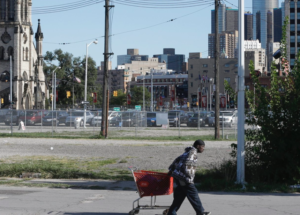
The troubling results found that the DNA of poor people in urban communities was rapidly deteriorating at a pace that exceeded that of most of the wealthier subjects, but it was the racial breakdown of the findings that shook up the conversation.
When it comes to the negative impact that race and discrimination have on health, the hierarchy usually doesn’t change much.
Poor Black people typically fare the worst and wealthy white people fare the best.
Not in this study.
Researchers analyzed a part of the DNA known as the telomeres, which are “tiny caps at the ends of DNA strands, akin to the plastic caps at the end of shoe laces, that protect cells from aging prematurely,” the Huffington Post explains.
These telomeres naturally shorten with age, but intense chronic stress, among other factors, can accelerate this process and leave the telomeres drastically shorter.
These short telomeres are associated with many serious medical issues like cancer, heart diseases and diabetes.
The study focused on poor and lower middle-class residents in Detroit that were either Black, white or Mexican and revealed that chronic stress cannot be tied directly to race but rather to perception and life experiences.
This was demonstrated by the fact that poor white people actually had the shortest telomeres while their wealthier counterparts had the longest telomeres.
Among the Mexican population in the city, poor Mexicans actually had longer telomeres than Mexicans with higher incomes.
According to researchers, it was likely caused by the different perceptions of America and life experiences associated with poor Mexicans in Detroit compared to those of the lower middle class.
Dr. Arline Geronimus, a visiting scholar at the Stanford Center for Advanced Study and the lead author behind the study, noted that many of the poor Mexicans were first-generation immigrants to the U.S. while the lower middle-class Mexicans were more likely to be born in the U.S. and “integrated into American culture through work or school.”
“If they’re immigrants, then they come with a different cultural background and upbringing that didn’t stress that as Mexicans they were somehow ‘other’ or ‘lesser’ than other Americans,” Geronimus explained to the Huffington Post. “They come with a set of support systems and with cultural orientation that doesn’t undermine their sense of self-worth. They then often live in these ethnic enclaves, many of them don’t speak anything other than Spanish, and so they’re not interacting with Americans who view them as ‘other’ or who treat them badly.”
It’s this relationship between the Mexican subjects that makes the findings among the Black subjects all the more intriguing.
Contrary to their white and Mexican counterparts, Black people actually didn’t have a drastic variation in the size of their telomeres. They were all shorter than what may be considered standard.
And so the argument that classicism is a greater problem than racism seems to crumble.
As stars like Chris Rock and Jamie Foxx have pointed out in the past, discrimination tends to follow Black people regardless of their socioeconomic status. The life experiences that Black people faced regarding racial discrimination, unfortunately, can’t even be dissipated with economic gains in most cases.
When examining Black people in a particular urban community, there was no great variation in the life experiences and perceptions of discrimination by the poor compared to that of those who were financially better off.
Either way, Geronimus insists that the study is proof that the discussion of discrimination and disparities in America is more complicated than just race or just economics or just location.
It’s a combination of all these things and then some.
“We’ve relied on [race, income and education level] too much to be the signifiers of everything that varies in the life experiences of different racial or ethnic groups in different geographic locations and circumstances,” she said. “… race is not race is not race. Poverty is not poverty is not poverty. Early health deterioration is sensitive to a broad range of life experiences.”
Researchers also noted the way segregation played a major role in life experiences and perception.
One group is less likely to feel like they are some sort of “other” if they rarely have encounters with those who have been deemed the “norm”— in this case, white people.
“Most blacks in our sample live almost exclusively with other blacks (97% of Eastside Detroit residents are black) or are the majority group in integrated neighborhoods (e.g., 70% of Northwest Detroit residents are black), [and] whites are a clear minority in all of our Detroit areas (ranging from 2% to 21% of residents),” researchers told the Huffington Post.
So how does this all explain the fact that poor white people in the community had the shortest telomeres?
The answer is one that underscores just how different life tends to be when one is basking in the benefits of white privilege.
In this particular community, where white people are not the majority and the effects of white privilege are not as concentrated as other areas, white people are faced with a more stressful life experience on a daily basis.
“Perhaps with the exodus of most whites and many jobs from Detroit, the shrinking benefits of labor union membership and public pensions, and the overall reduction in taxation-based city services, the poor whites who remain are particularly adversely affected by the social and ecological consequences of austerity urbanism,” researchers suggested. “Lacking the financial resources, social networks, and identity affirmation of the past, remaining Detroit whites may have less to protect them from the health effects of poverty, stigma, anxiety, or hopelessness in this setting.”


